What You Need to Know About Separating, Filtering, Clarifying, Precipitating, and Still Machine Setter, Operator, or Tender
Separating, Filtering, Clarifying, Precipitating, & Still Machine Operator Definition Set up, operate, or tend continuous flow or vat-type equipment; filter presses; shaker screens; centrifuges; condenser tubes; precipitating, fermenting, or evaporating tanks; scrubbing towers; or batch stills. These machines extract, sort, or separate liquids, gases, or solids from other materials to recover a refined product. Includes dairy processing equipment operators.
Life As a Separating, Filtering, Clarifying, Precipitating, & Still Machine Operator
- Start agitators, shakers, conveyors, pumps, or centrifuge machines.
- Collect samples of materials or products for laboratory analysis.
- Measure or weigh materials to be refined, mixed, transferred, stored, or otherwise processed.
- Connect pipes between vats and processing equipment.
- Turn valves to pump sterilizing solutions or rinse water through pipes or equipment or to spray vats with atomizers.
- Maintain logs of instrument readings, test results, or shift production for entry in computer databases.
Featured schools near , edit
What a Separating, Filtering, Clarifying, Precipitating, & Still Machine Operator Should Know
Below is a list of the skills most Separating, Filtering, Clarifying, Precipitating, and Still Machine Setters, Operators, and Tenders say are important on the job.
Operation Monitoring: Watching gauges, dials, or other indicators to make sure a machine is working properly.
Critical Thinking: Using logic and reasoning to identify the strengths and weaknesses of alternative solutions, conclusions or approaches to problems.
Monitoring: Monitoring/Assessing performance of yourself, other individuals, or organizations to make improvements or take corrective action.
Operation and Control: Controlling operations of equipment or systems.
Quality Control Analysis: Conducting tests and inspections of products, services, or processes to evaluate quality or performance.
Reading Comprehension: Understanding written sentences and paragraphs in work related documents.
Types of Separating, Filtering, Clarifying, Precipitating, & Still Machine Operator Jobs
- Potato Peeler
- Flotation Tank Operator
- Mercury Washer
- Sorting Machine Operator
- Egg Pasteurizer
Separating, Filtering, Clarifying, Precipitating, & Still Machine Operator Job Outlook
In the United States, there were 47,200 jobs for Separating, Filtering, Clarifying, Precipitating, and Still Machine Setter, Operator, or Tender in 2016. There is little to no growth in job opportunities for Separating, Filtering, Clarifying, Precipitating, and Still Machine Setter, Operator, or Tender. Due to new job openings and attrition, there will be an average of 5,000 job openings in this field each year.
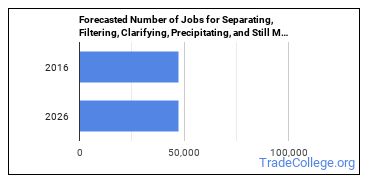
The states with the most job growth for Separating, Filtering, Clarifying, Precipitating, & Still Machine Operator are Vermont, Oregon, and Washington. Watch out if you plan on working in Ohio, North Carolina, or Maine. These states have the worst job growth for this type of profession.
Do Separating, Filtering, Clarifying, Precipitating, and Still Machine Setters, Operators, and Tenders Make A Lot Of Money?
The salary for Separating, Filtering, Clarifying, Precipitating, and Still Machine Setters, Operators, and Tenders ranges between about $26,070 and $67,630 a year.
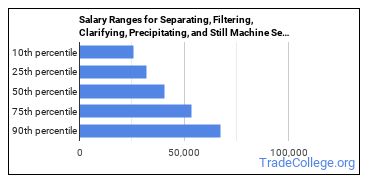
Separating, Filtering, Clarifying, Precipitating, and Still Machine Setters, Operators, and Tenders who work in Wyoming, Nevada, or New Hampshire, make the highest salaries.
How much do Separating, Filtering, Clarifying, Precipitating, and Still Machine Setters, Operators, and Tenders make in different U.S. states?
| State | Annual Mean Salary |
|---|---|
| Alabama | $38,030 |
| Alaska | $38,240 |
| Arizona | $42,730 |
| Arkansas | $38,350 |
| California | $47,490 |
| Colorado | $44,500 |
| Connecticut | $43,360 |
| Delaware | $40,560 |
| Florida | $39,760 |
| Georgia | $37,320 |
| Hawaii | $34,620 |
| Idaho | $39,870 |
| Illinois | $46,170 |
| Indiana | $42,520 |
| Iowa | $42,600 |
| Kansas | $35,410 |
| Kentucky | $39,970 |
| Maine | $47,890 |
| Maryland | $43,160 |
| Massachusetts | $44,280 |
| Michigan | $38,350 |
| Minnesota | $41,460 |
| Missouri | $40,330 |
| Montana | $47,370 |
| Nebraska | $34,500 |
| Nevada | $57,990 |
| New Hampshire | $56,440 |
| New Jersey | $55,230 |
| New Mexico | $37,410 |
| New York | $45,140 |
| North Carolina | $48,720 |
| North Dakota | $41,780 |
| Ohio | $46,070 |
| Oklahoma | $33,430 |
| Oregon | $40,210 |
| Pennsylvania | $42,080 |
| South Carolina | $40,620 |
| South Dakota | $38,670 |
| Tennessee | $37,990 |
| Texas | $44,420 |
| Utah | $43,010 |
| Vermont | $40,290 |
| Virginia | $44,180 |
| Washington | $39,130 |
| West Virginia | $40,160 |
| Wisconsin | $40,460 |
| Wyoming | $73,340 |
What Tools & Technology do Separating, Filtering, Clarifying, Precipitating, and Still Machine Setters, Operators, and Tenders Use?
Although they’re not necessarily needed for all jobs, the following technologies are used by many Separating, Filtering, Clarifying, Precipitating, and Still Machine Setters, Operators, and Tenders:
- Microsoft Excel
- Microsoft Word
- Microsoft Office
- Microsoft PowerPoint
- Microsoft Outlook
- Data entry software
- Email software
- Word processing software
- SAP
- Spreadsheet software
How do I Become a Separating, Filtering, Clarifying, Precipitating, & Still Machine Operator?
What education is needed to be a Separating, Filtering, Clarifying, Precipitating, and Still Machine Setter, Operator, or Tender?
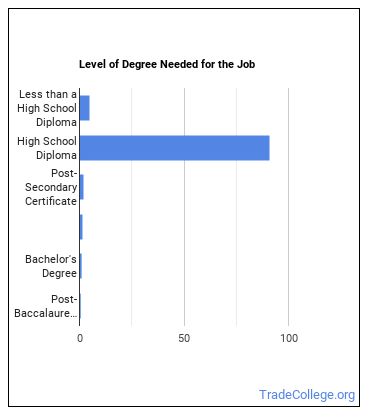
How many years of work experience do I need?
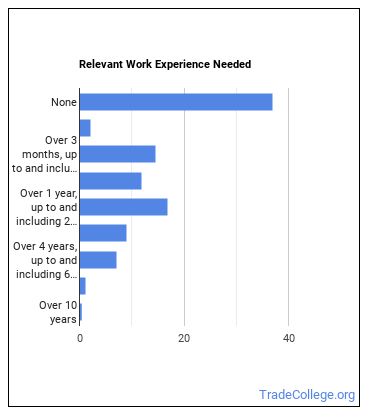
Where Separating, Filtering, Clarifying, Precipitating, and Still Machine Setters, Operators, and Tenders Are Employed
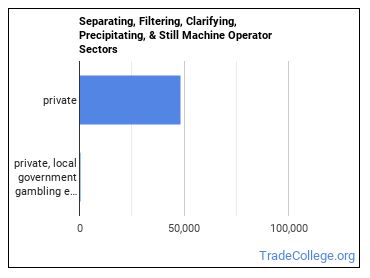
The table below shows some of the most common industries where those employed in this career field work.
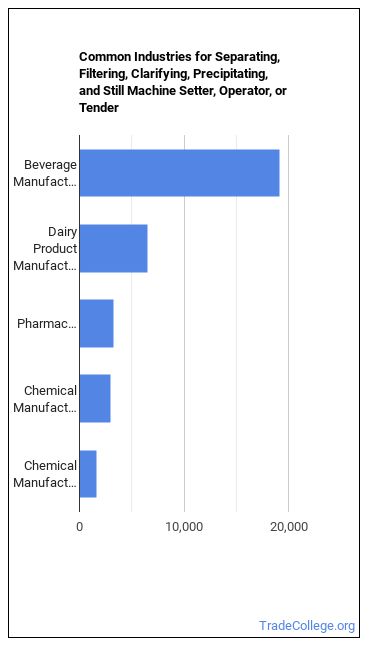
You May Also Be Interested In…
Those interested in being a Separating, Filtering, Clarifying, Precipitating, and Still Machine Setter, Operator, or Tender may also be interested in:
Are you already one of the many Separating, Filtering, Clarifying, Precipitating, and Still Machine Setter, Operator, or Tender in the United States? If you’re thinking about changing careers, these fields are worth exploring:
References:
More about our data sources and methodologies.
Featured Schools
 Request Info
Request Info
|
Southern New Hampshire University You have goals. Southern New Hampshire University can help you get there. Whether you need a bachelor's degree to get into a career or want a master's degree to move up in your current career, SNHU has an online program for you. Find your degree from over 200 online programs. Learn More > |
